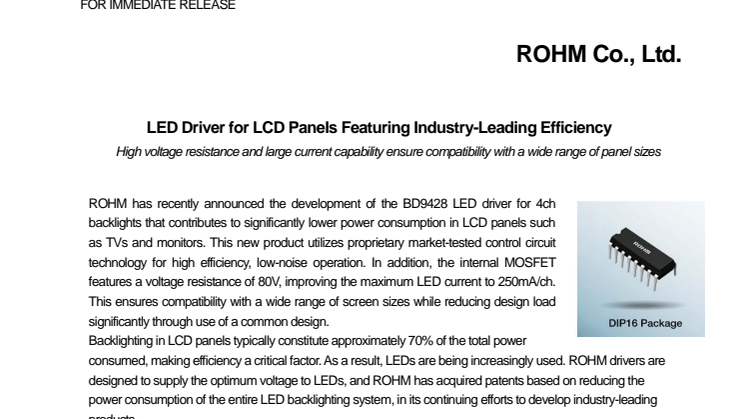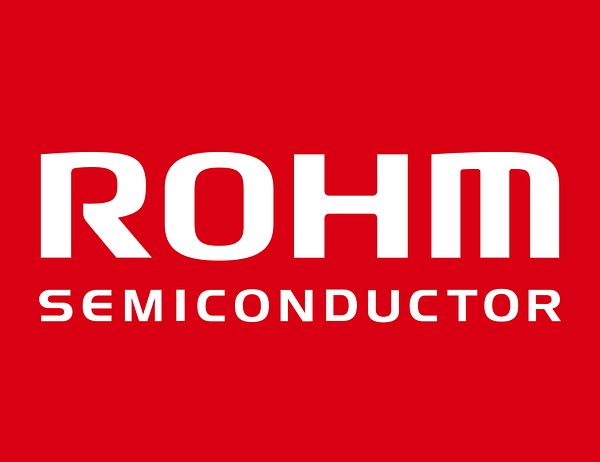News -
LED Driver for LCD Panels Featuring Industry-Leading Efficiency: High voltage resistance and large current capability ensure compatibility with a wide range of panel sizes
ROHM has recently announced the development of the BD9428 LED driver for
4ch backlights that contributes to significantly lower power consumption in LCD
panels such as TVs and monitors. This new product utilizes proprietary
market-tested control circuit technology for high efficiency, low-noise
operation. In addition, the internal MOSFET features a voltage resistance of
80V, improving the maximum LED current to 250mA/ch. This ensures compatibility
with a wide range of screen sizes while reducing design load significantly
through use of a common design.
Backlighting in LCD panels typically constitute approximately 70% of the total power consumed, making efficiency a critical factor. As a result, LEDs are being increasingly used. ROHM drivers are designed to supply the optimum voltage to LEDs, and ROHM has acquired patents based on reducing the power consumption of the entire LED backlighting system, in its continuing efforts to develop industry-leading products.
At the same time there is a greater demand to configure the LED driver in the backlighting section and the AC/DC converter of the primary power supply block on the same substrate in order to minimize design time and reduce costs. However, this can pose difficulties when attempting to increase voltage resistance and current handling capability, not to mention implementing heat generation countermeasures.
Generally, to solve these issues an external MOSFET for driving the LEDs was often used. But this came with its own challenges, in the form of larger mounting area and higher component costs.
In response, ROHM utilized cutting-edge high voltage resistance BiC-DMOS processes, successfully increasing LED terminal voltage from 60V to 80V and LED current from 150mA/ch to 250mA/ch on a single chip. And for coil noise that can occur with high voltage resistances and large currents, a proprietary circuit is built in that smoothes the current waveform during PWM dimming, while circuit optimization ensures safe operation even with shorter pulse signals.
In addition, a patented high efficiency system improves efficiency by 10% over conventional control methods, contributing significantly to lower device power consumption. And by employing a DIP package, heat dissipation problems associated with the use of a shared substrate are eased, enabling support for a variety of panel sizes while reducing design costs and shortening development time.
Pricing: 200yen/unit (Samples)
Availability: September (Samples), November (OEM quantities)
Key Features
1. Patented high efficiency system circuitry provides significant energy savings
Generally, for LED backlighting, the LED supply voltage is monitored and controlled. In contrast, ROHM monitors the cathode voltage of each LED in order to maintain a constant LED supply voltage at the lowest level possible. This control method allows for an optimized supply voltage, improving efficiency by 10% compared with conventional methods. This waste-free high efficiency system contributes to lower device power consumption.
US Patent No: 7,235,954; 7,541,785; 7,944,189; 8,242,7562. Original PWM circuit ensures low noise even at high currents
Coil noise generated at higher currents is prevented by a proprietary built-in circuit that smoothes the current waveform during PWM dimming. The result is superior low-noise characteristics.
3. Leading-edge processes utilized for higher voltage resistance and current-handling capability, enabling support for a wide range of screen sizes
ROHM’s cutting-edge high voltage resistance BiC-DMOS processes increase LED terminal voltage from 60V to 80V and LED current from 150mA/ch to 250mA/ch (max.), ensuring compatibility with a range of screen sizes while facilitating the introduction of common model designs.
4. DIP package facilitates heat dissipation measures
Utilizing a DIP package simplifies thermal countermeasures (i.e. heat sinks). This allows for a common single-layer board design while saving valuable substrate area.
Terminology
・BiC-DMOS Process
Combines bipolar, CMOS, and DMOS processes. Make it possible to achieve a mixture of analog, digital, miniaturization, and high voltage resistance.
・PWM (Pulse Width Modulation)
A modulation method that lengthens/shortens the output time of pulse signals to control current and voltage.Topics
- Engineering

